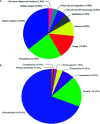Immunoproteomics Reveals Pathogen's Antigens Involved in Homo sapiens- Histoplasma capsulatum Interaction and Specific Linear B-Cell Epitopes in Histoplasmosis
- PMID: 33251160
- PMCID: PMC7673445
- DOI: 10.3389/fcimb.2020.591121
Immunoproteomics Reveals Pathogen's Antigens Involved in Homo sapiens- Histoplasma capsulatum Interaction and Specific Linear B-Cell Epitopes in Histoplasmosis
Abstract
Histoplasmosis is one of the most frequent systemic mycosis in HIV patients. In these patients, histoplasmosis has high rates of morbidity/mortality if diagnosis and treatment are delayed. Despite its relevance, there is a paucity of information concerning the interaction between Histoplasma capsulatum and the human host, especially regarding the B-cell response, which has a direct impact on the diagnosis. Culture-based "gold-standard" methods have limitations, making immunodiagnostic tests an attractive option for clinical decisions. Despite the continuous development of those tests, improving serological parameters is necessary to make these methods efficient tools for definitive diagnosis of histoplasmosis. This includes the determination of more specific and immunogenic antigens to improve specificity and sensitivity of assays. In this study, we performed a co-immunoprecipitation assay between a protein extract from the yeast form of H. capsulatum and pooled sera from patients with proven histoplasmosis, followed by shotgun mass spectrometry identification of antigenic targets. Sera from patients with other pulmonary infections or from healthy individuals living in endemic areas of histoplasmosis were also assayed to determine potentially cross-reactive proteins. The primary structures of H. capsulatum immunoprecipitated proteins were evaluated using the DNAStar Protean 7.0 software. In parallel, the online epitope prediction server, BCPREDS, was used to complement the B-epitope prediction analysis. Our approach detected 132 reactive proteins to antibodies present in histoplasmosis patients' sera. Among these antigens, 127 were recognized also by antibodies in heterologous patients' and/or normal healthy donors' sera. Therefore, the only three antigens specifically recognized by antibodies of histoplasmosis patients were mapped as potential antigenic targets: the M antigen, previously demonstrated in the diagnosis of histoplasmosis, and the catalase P and YPS-3 proteins, characterized as virulence factors of H. capsulatum, with antigenic properties still unclear. The other two proteins were fragments of the YPS-3 and M antigen. Overlapping results obtained from the two aforementioned bioinformatic tools, 16 regions from these three proteins are proposed as putative B-cell epitopes exclusive to H. capsulatum. These data reveal a new role for these proteins on H. capsulatum interactions with the immune system and indicate their possible use in new methods for the diagnosis of histoplasmosis.
Keywords: Histoplasma capsulatum; Homo sapiens; M antigen; YPS-3; catalase P; epitopes; immunoproteome; mass spectrometry.
Copyright © 2020 Almeida, Almeida-Paes, Guimarães, Valente, Soares and Zancopé-Oliveira.
Figures




References
-
- Albuquerque P. C., Nakayasu E. S., Rodrigues M. L., Frases S., Casadevall A., Zancope-Oliveira R. M., et al. (2008). Vesicular transport in Histoplasma capsulatum: an effective mechanism for trans-cell wall transfer of proteins and lipids in ascomycetes. Cell Microbiol. 10, 1695–1710. 10.1111/j.1462-5822.2008.01160.x - DOI - PMC - PubMed
-
- Almeida M. A., Damasceno L. S., Pizzini C. V., Muniz M. M., Almeida-Paes R., Zancopé-Oliveira R. M. (2019). Role of western blot assay for the diagnosis of histoplasmosis in AIDS patients from a National Institute of Infectious Diseases in Rio de Janeiro, Brazil. Mycoses 62, 261–267. 10.1111/myc.12877 - DOI - PubMed
Publication types
MeSH terms
Substances
LinkOut - more resources
Full Text Sources
Medical

